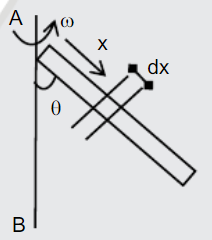A solid body rotates about a stationary axis so that its angular velocity depends upon the rotation angle as , where a and are positive constants. Initially that is at t .
The correct Answer is:A, C
To solve the problem, we need to analyze the relationship between angular velocity (ω), the rotation angle (φ), and time (t) based on the given equation:
ω−ω0=−aϕ
where a and ω0 are positive constants.
1. Understanding the Relationship:
The equation can be rearranged to express angular velocity in terms of the rotation angle:
ω=ω0−aϕ
2. Relating Angular Velocity and Angle:
The angular velocity is defined as the rate of change of the angle with respect to time:
dϕdt=ω
Substituting for ω:
dϕdt=ω0−aϕ
3. Separating Variables:
We can rearrange this equation to separate variables:
dϕω0−aϕ=dt
4. Integrating Both Sides:
We will integrate both sides. The left side will be integrated from ϕ=0 to ϕ, and the right side from t=0 to t:
∫ϕ0dϕω0−aϕ=∫t0dt
5. Calculating the Left Integral:
The left integral can be solved using the natural logarithm:
−1aln|ω0−aϕ|∣∣∣ϕ0=t
Evaluating the limits:
−1a(ln(ω0−aϕ)−ln(ω0))=t
This simplifies to:
−1aln(ω0−aϕω0)=t
6. Exponentiating Both Sides:
To eliminate the logarithm, we exponentiate both sides:
ω0−aϕω0=e−at
Rearranging gives:
ω0−aϕ=ω0e−at
7. Solving for φ:
Now, we can solve for ϕ:
aϕ=ω0−ω0e−at
ϕ=ω0(1−e−at)a
Final Expression:
Thus, the expression for the rotation angle ϕ in terms of time t is:
ϕ=ω0a(1−e−at)
The equation can be rearranged to express angular velocity in terms of the rotation angle:
ω=ω0−aϕ
The angular velocity is defined as the rate of change of the angle with respect to time:
dϕdt=ω
Substituting for ω:
dϕdt=ω0−aϕ
We can rearrange this equation to separate variables:
dϕω0−aϕ=dt
We will integrate both sides. The left side will be integrated from ϕ=0 to ϕ, and the right side from t=0 to t:
∫ϕ0dϕω0−aϕ=∫t0dt
The left integral can be solved using the natural logarithm:
−1aln|ω0−aϕ|∣∣∣ϕ0=t
Evaluating the limits:
−1a(ln(ω0−aϕ)−ln(ω0))=t
This simplifies to:
−1aln(ω0−aϕω0)=t
To eliminate the logarithm, we exponentiate both sides:
ω0−aϕω0=e−at
Rearranging gives:
ω0−aϕ=ω0e−at
Now, we can solve for ϕ:
aϕ=ω0−ω0e−at
ϕ=ω0(1−e−at)a
Thus, the expression for the rotation angle ϕ in terms of time t is:
ϕ=ω0a(1−e−at)
Topper's Solved these Questions
- KINEMATICSBOOK - FIITJEECHAPTER - KINEMATICSEXERCISE - ASSERTION-REASON MCQ ( SINGLE CORRECT)
8 Videos
- KINEMATICSBOOK - FIITJEECHAPTER - KINEMATICSEXERCISE - PARAGRAPH -V
2 Videos
- KINEMATICSBOOK - FIITJEECHAPTER - KINEMATICSEXERCISE - SECTION(II) : MCQ ( SINGLE CORRECT)
47 Videos
- HEAT AND TEMPERATUREBOOK - FIITJEECHAPTER - HEAT AND TEMPERATUREEXERCISE - NUMERICAL BASES QUESTIONS
1 Videos
- LAWS OF MOTIONBOOK - FIITJEECHAPTER - LAWS OF MOTIONEXERCISE - COMPREHENSION-III
2 Videos
Similar Questions
A solid body rotates about a stationary axis so that its angular velocity depends on the rotation angle φ as ω=ω0−aφ, where ω0 and a are positive constants. At the moment t=0 the angle φ=0. Find the time dependence of
(a) the rotation angle,
(b) the angular velocity.
View SolutionAngular momentum of a rigid body rotating about a fixed Axis with angular velocity →ω
View Solution
Knowledge Check
A solid body rotates about a stationary axis so that its angular velocity depends on the rotational angle ϕ as ω=ω0−kϕ where ω0 and k are positive constants. At the moment t = 0, ϕ=0, the time dependence of rotation angle is
Akω0e−ktBω0ke−ktCω0K(1−e−kt)Dkω0(e−kt−1)A solid body rotest about a stationary axis, so that its angular velocity depends on the rotational angle ϕ as ω=ω0−kϕ where ω0 and K are postitive constatns. At the moment t=0,ϕ=0 Find the dependence of rotaions angle.
Akω0e−ktBω0ke−ktCω0k(1−e−kt)Dkω0(e−kt−1)A solid body rotates about a stationary axis so that its angular velocity depends on the rotation angle as = 0 – k , where 0 and k are positive constants. At the moment t = 0, the angle = 0. Find the time dependence of rotation angle -
AK.ω0e−KTBω0K[e−Kt]Cω0K[1−e−Kt]DKω0[e−Kt−1]
Evaluate ∫t_0Asinωdt where A and omega are constants.
View SolutionY=5sin(3ωt+ϕ) where ω andϕ are constant. Finf dydx
View SolutionA solid body starts rotating about a stationary axis with an angular acceleration α=α0cosθ, where α0 is a constant and θ is an angle of rotation from the initial position. Find the angular velocity of the body as a function of θ.
View SolutionA rod is rotating with angular velocity ω about axis AB. Find cosθ.

View SolutionA solid cylinder of mass M and radius R rotates about its axis with angular speed ω. Its rotational kinetic energy is
View Solution
